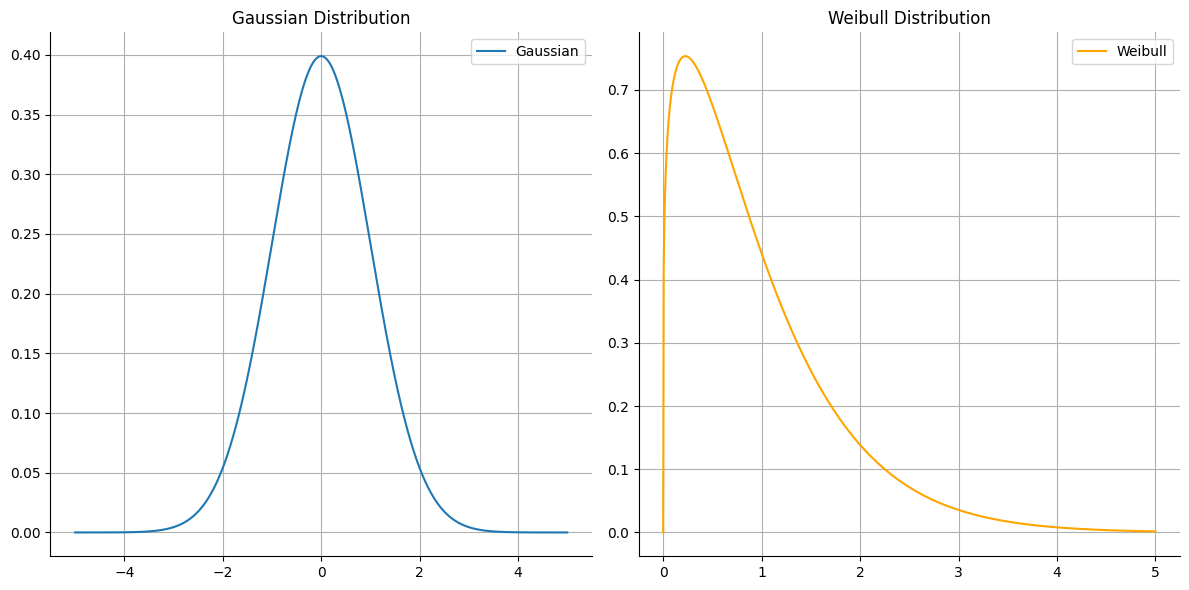Kapital#
1. f(t)
\
2. S(t) -> 4. y:h'(f)=0;t(X'X).X'Y -> 5. b(c) -> 6. SV'
/
3. h(t)
\(\mu\), Chaos#
Text: distribution of social income
Cumulation of wealth
Time in life when most is made
\(\sigma\), Order#
Context: homogeneity vs. stronger influences of migration
\(\%\), Accuracy#
Pretext: vector of coefficients that determine subgroup identity
Individualized profile
Show code cell source
import matplotlib.pyplot as plt
import numpy as np
from scipy.stats import norm, weibull_min
# Data for the Gaussian distribution
x_gaussian = np.linspace(-5, 5, 1000)
y_gaussian = norm.pdf(x_gaussian)
# Data for the Weibull distribution
c = 1.2 # Shape parameter
x_weibull = np.linspace(0, 5, 1000)
y_weibull = weibull_min.pdf(x_weibull, c)
# Create the 1x2 panel
fig, axes = plt.subplots(1, 2, figsize=(12, 6))
# Plot Gaussian distribution
axes[0].plot(x_gaussian, y_gaussian, label='Gaussian')
axes[0].grid(True)
axes[0].set_title('Gaussian Distribution')
axes[0].spines['top'].set_visible(False)
axes[0].spines['right'].set_visible(False)
axes[0].legend()
# Plot Weibull distribution
axes[1].plot(x_weibull, y_weibull, label='Weibull', color='orange')
axes[1].grid(True)
axes[1].set_title('Weibull Distribution')
axes[1].spines['top'].set_visible(False)
axes[1].spines['right'].set_visible(False)
axes[1].legend()
# Show plot
plt.tight_layout()
plt.show()


Distribution of biological traits vs. family wealth. Capitalism is associated with the Weibull distribution. Communism claims to offer a uniform distribution.#
Essay#
Communist governments in China and Russia adopted atheism largely because it aligned with Marxist-Leninist ideology. Marxism-Leninism views religion as an instrument of social control used by ruling classes to oppress the working class. Karl Marx famously called religion the “opium of the people,” suggesting that it was a tool to placate the masses and divert their attention from the injustices and inequalities of capitalist societies.
In Russia, the Bolsheviks, led by Vladimir Lenin, sought to dismantle the influence of the Russian Orthodox Church, which was closely tied to the Tsarist regime. They believed that religion perpetuated a feudal, oppressive system and wanted to replace it with a secular, socialist state that promoted scientific atheism. The Soviet government aimed to create a new social order based on rationality and scientific progress, free from religious superstitions.
Similarly, in China, the Communist Party under Mao Zedong viewed religion, particularly traditional Chinese practices and Buddhism, as remnants of feudalism and imperialist influence. The Chinese Communist Party (CCP) sought to modernize China and eliminate any potential threats to its ideological purity and political control. They promoted atheism and attempted to suppress religious practices to unify the population under communist ideology and foster a collective socialist identity.
Both governments also saw religious institutions as potential sources of political opposition and social unrest. By promoting atheism and undermining religious institutions, they aimed to consolidate their power and maintain control over their populations.
The atheism of communist regimes in China and Russia was not merely a matter of philosophical alignment but a strategic move to eradicate any competing sources of authority and loyalty, ensuring that the state remained the ultimate authority in both ideological and practical terms.

